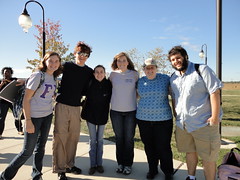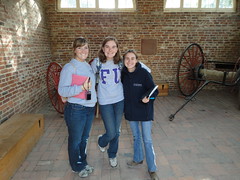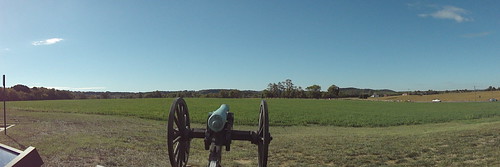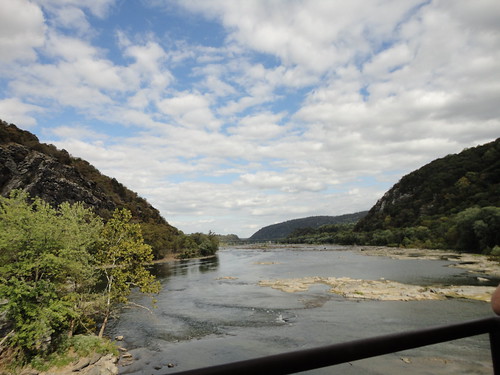With bleary eyes and intermittent yawns, we loaded the Gettysburg Sprinter with Dr. Norman at eight a.m., settling in for the short ride to our first battlefield of the semester. We drove past the now familiar fields of Gettysburg towards Maryland with excitement dulled only slightly by the early hour. We would begin our day at the near end of the war in 1864 at Monocacy Junction. We would finish it at Harper’s Ferry where some argue, the opening shots of the Civil War were fired.
 We made our first stop of the day at Monocacy, Maryland to meet with our guide Gail Stephens. Her passion for the battlefield and those who fought in the area on July 9, 1864, was evident as she led us across the fields opposite the Best House. She proceeded to explain Confederate Jubal Early’s plan to destroy the Baltimore Ohio Railroad at Monocacy in order to threaten Washington D.C. by cutting it off from the Western Front. Union Major General Lew Wallace determined to hold his position at Monocacy to keep Early and the Confederates from marching on Washington.
We made our first stop of the day at Monocacy, Maryland to meet with our guide Gail Stephens. Her passion for the battlefield and those who fought in the area on July 9, 1864, was evident as she led us across the fields opposite the Best House. She proceeded to explain Confederate Jubal Early’s plan to destroy the Baltimore Ohio Railroad at Monocacy in order to threaten Washington D.C. by cutting it off from the Western Front. Union Major General Lew Wallace determined to hold his position at Monocacy to keep Early and the Confederates from marching on Washington.
After touring the railway junction held by Lieutenant Davis and the Maryland and Vermont attachments, we made our way to the Thomas Farm where most of the fighting took place. The experience of standing on the same terrain as the legends Early and Wallace was truly moving. Because of Wallace’s stand at Monocacy, the Confederates lost an important day to move on Washington, ultimately leading to Early’s retreat to the Shenandoah Valley on the 12th of July. Wallace may have lost the battle, but he saved Washington that day.
Interestingly enough, the Thomas Farm is still standing as it did during the battle. Gail informed us that the Park Service is currently working on restoring the Thomas Farm in order to enhance the visitor experience at Monocacy. Visiting after the restoration is complete will be fascinating.
As we returned to the Visitor Center, we passed the Best House where, in September 1862, cigars wrapped in Lee’s plans for Antietam were found by Union soldiers and sent to D.H. Hill. This fact reminded us that the Civil War wasn’t merely a barrage of single episodic battles, but rather a continuous drama with overlapping events and places.
 We left Gail Stephens and the end of the war for Dennis Frye and the beginning of the war at Harper’s Ferry around noon. After a delicious lunch in Bolivar Heights, we made our way down to Harper’s Ferry to retrace John Brown’s steps during his raid in October 1859. We stood overlooking three states (West Virginia, Virginia, and Maryland) as Dennis challenged our previous assumptions about Brown and his motives for his raid. His narrative style created an experience unlike any other as we set ourselves in John Brown’s world to understand his motives and hopes for the future of slavery and America. We sat in the Engine House as Dennis recounted the tense moments leading up to Brown’s capture and the end of the raid. The silence of the room following the retelling left us all with the eerie feeling of touching an event that had happened over 150 years ago.
We left Gail Stephens and the end of the war for Dennis Frye and the beginning of the war at Harper’s Ferry around noon. After a delicious lunch in Bolivar Heights, we made our way down to Harper’s Ferry to retrace John Brown’s steps during his raid in October 1859. We stood overlooking three states (West Virginia, Virginia, and Maryland) as Dennis challenged our previous assumptions about Brown and his motives for his raid. His narrative style created an experience unlike any other as we set ourselves in John Brown’s world to understand his motives and hopes for the future of slavery and America. We sat in the Engine House as Dennis recounted the tense moments leading up to Brown’s capture and the end of the raid. The silence of the room following the retelling left us all with the eerie feeling of touching an event that had happened over 150 years ago.
The ride home was filled with excited discussion interspersed with “Take Me Home Country Road” as we crossed back into Virginia and Maryland. We returned to the Appleford with a deeper knowledge of the battle at Monocacy, and a deeper appreciation of John Brown’s actions in 1859. We’ve made it through the opening scene of the war at Harper’s Ferry; it’s time to see the first action in Manassas Junction, Virginia. On to Manassas!


No comments:
Post a Comment